Top 10 Indoor Plants for Low Light
BackOne of the most common reasons for indoor plants to fail is simply a lack of light. As a result, that beautiful plant you purchased from the nursery may drop leaves, produce lanky stems or simply refuse to grow. Even worse, it may just curl up it's toes and die.
However every room deserves some living greenery! That's why we've created a list of the best plants to grow in low light. Whilst many plants can't handle low light conditions these tough guys are able to tolerate it. Just remember that even these plants ideally prefer to grow in bright to medium light, so they'll appreciate being swapped out or moved to a brighter situation from time to time. Rotating them around will allow them to grow better in the long run, and it's a good excuse to have more plants!
Keep in mind, low-light does not mean no-light. So if you've got a bathroom without a window, or another room which is extremely dark, then any plant is going to struggle.

.
Devil’s ivy (Epipremnum aureum)
Due to it's tolerance of neglect and low light situations, devil’s ivy is one of the most common climbing or trailing plants you see in offices, shopping centres and perhaps even at your local doctor’s office. It is also commonly called pothos.
The straight species has rich green leaves with golden markings, but these days there are many cultivars available with different patterns including ‘Marble Queen’, ‘Snow Queen, and ‘N’Joy’. Keep in mind that the variegation will become less pronounced in low light. You can encourage more variegation by moving them to a brightly lit room for a period. There is also a beautiful cultivar with solid golden/lime green foliage called 'Neon' or 'Goldilocks'.
Grow any of the devil's ivy in free-draining potting mix and allow the stems to hang or trail all over the place. Alternatively you can train it to climb up a moss pole. Cuttings will happily live in a jar of water for months and months as well.
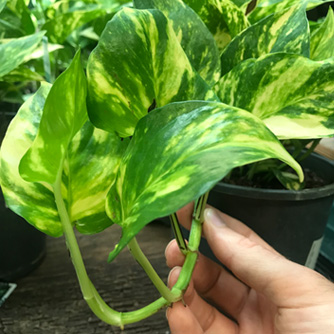
Devil's ivy
Snake plant (Dracaena trifasciata)
Now this is a plant you see almost everywhere due to it's ability to tolerate a wide variety of conditions, including low light and low water. It’s often planted en masse in shopping centres or as office displays because it can be relied on to perform well with minimal care.
The most common type are the plants with long, narrow foliage that is dark green with yellow markings. Now there are other varieties that have broad leaves and come in paler colours or with interesting patterns. Once you have one you might just want to collect them all!
Whichever type you go for, make sure they have good drainage and aren't overwatered. As a succulent, they will be susceptible to rotting away if you're a bit too keen with watering.
Learn more about caring for the snake plant here.
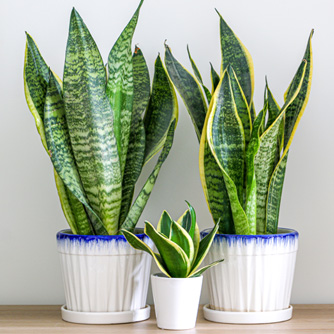
Collection of snake plants
Peace lily (Spathiphyllum)
The peace lily is a classic indoor plant with attractive glossy green foliage and white flowers. It's another popular plant for shopping centres and offices because it will tolerate low light. Just keep in mind that the flowers are less likely to appear in low light, but you can still enjoy their dark green leaves.
If you want something a bit different then look out for 'Sensation' which is a giant peace lily with much larger leaves and grows taller. Perfect for creating a jungle look. If you want variegated foliage then look out for ‘Domino’ or ‘Picasso’ which have flecks or splashes of white on their leaves. Keep in mind that this variegation will be less pronounced in low light.
Peace lilies will also tell you when they are thirsty by drooping quite dramatically. They will, however, quickly bounce back once watered.
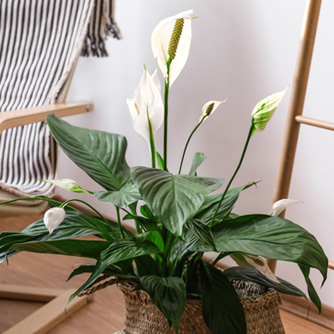
Peace lilies are popular elegant indoor plants
ZZ plant (Zamioculcus zamiifolia)
This hardy indoor plant is accepting of low light and low watering. It has handsome dark-green leaves on tall, slightly flexed stems. Many gravitate towards this plant due to it's good looks and low care requirements – it's fleshy rhizomes allow it to go without watering for a few weeks. Growth is usually quite slow in low light, so if you're wanting to make an impact straightaway, spend the money on buying an advanced plant.
Best known as ZZ plant thanks to the initials of it's botanical name (what a mouthful that is!), but also sold as Zanzibar Gem.
They must have good drainage especially if you have a tendency to overwater your indoor plants. Excess water around the roots will cause root and stem rot, so if ever in doubt, wait a few extra days before watering again.
Learn more about caring for ZZ plants here.
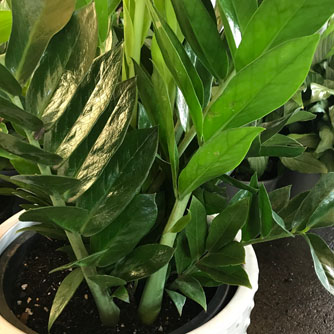
ZZ plant or Zanzibar Gem
Cast iron plant (Aspidistra elatior)
The large, dark green foliage of the cast iron plant absolutely thrives in shade, so it’s great for poorly lit rooms. Plants with solid green leaves are the most commonly available, but if you're lucky you'll be able to find some of the cultivars with variegated foliage.
The cast iron plant is very tolerant of neglect and can withstand fairly long dry periods once established. Of course it will eventually need watering when the top 2.5-5 cm of mix is dry, but it can handle being overlooked when you go on holidays or are just a bit forgetful.
Unlike many indoor plants the cast iron plant is not cold sensitive so it will happily live in unheated rooms right through winter. If you choose to move it around the home, be sure it’s kept out of direct light as this is definitely a shade lover.
Cast iron plants are another slow grower, so it will happily live in the same sized pot for many years.
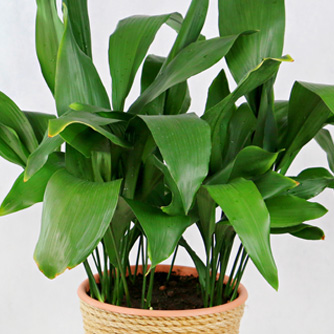
Cast iron plant or aspidistra
Flamingo flower (Anthurium andraeanum)
The glossy green, heart-shaped foliage of the flamingo flower is a sweet addition to rooms with low light. It does produce bright red or pink flowers, which explains its common name, but generally these only appear when the plant is grown in brightly lit situation. So for dark rooms, you'll mostly just have the lovely foliage. Hybrids also exist with different coloured flowers, but again, they will need bright light to keep them flowering.
Plant into very free draining potting mix and water regularly. The roots will enjoy regular moisture but not being waterlogged (hence the need for extra drainage). If using cover pots (decorative pots with no drainage holes), be sure that water doesn't sit in the base of the cover pot too.
Leaf edges may brown in environments with low humidity. If this occurs try increasing the humidity by grouping together with other similar plants (a good excuse to buy more plants hey?). Alternatively place the pot on top of a saucer filled with pebbles and water.
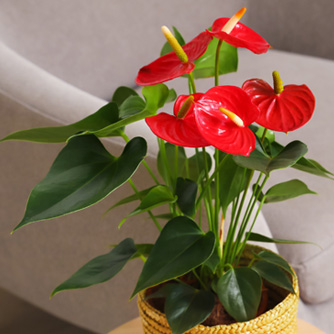
Flamingo flower with it's heart shaped leaves and unmissable flowers
Lady palm (Rhapis excelsa)
Palms belong in the warm, sunny tropics, right? While that is true for many palms, there are some that exist only in the understorey of subtropical or tropical rainforests. These palms have adapted to growing in the shade of others trees and are perfect for growing in low light. One such example is the beautiful lady palm.
The lady palm is an elegant, multi-stemmed palm with glossy dark green leaves. Each frond has a fan shape with makes this palm very distinctive. There is also a golden variegated form available.
This palm thrives in bright, indirect light but is quite tolerant of low-light spaces. Plant into a premium potting mix, water regularly and rotate every few months so it can enjoy better lit conditions.
The lady palm is a slow growing palm which can make them more expensive to buy, but they are definitely worth it.
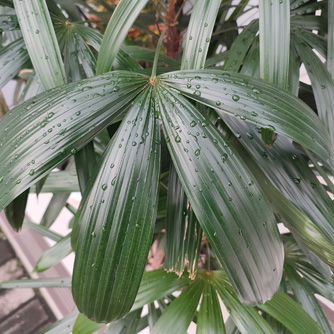
Fan shaped leaves of the lady palm
Chinese evergreen (Aglaonema spp. & hybrids)
This is another easy-to-grow houseplant that comes with highly ornamental foliage. For many years we only saw plants with solid green leaves or some with silver markings. However, thanks to some very clever breeding you can now find amazing hybrids that are splashed with pink and red colouring as well.
Chinese evergreen is adaptable to a range of light levels and will happily grow in reasonably low light conditions. However, if the plant becomes ‘leggy’ or stretched out, then it’s trying to reach for more light. If yours starts to do this, consider moving the plant every couple of months to a brighter spot. Also, if the varieties with colourful leaves start reverting to green, then it's another sign your plants needs more light.
To make a really impressive display why not group a few of the different coloured varieties together? They'll look stunning.
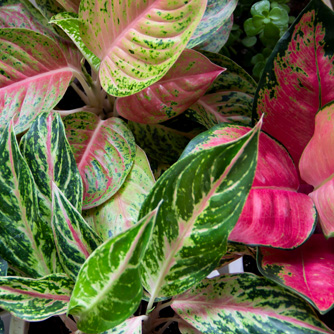
Chinese greens, or aglaonemas, come in a range of leaf patterns and colours
Happy plant (Dracaena fragrans ‘Massangeana’)
Now this is a houseplant that’s happy in almost any setting, from bright to very low light situations. It can be slow growing, but to get around this, nurseries commonly grow plants from the cuttings of mature plants. So this means you can easily buy plants with a highly textured woody trunk (the original cutting) that have a profusion of lush green and yellow striped leaves emerging from several spots.
Plant into a well draining potting mix and once established it'll be tolerant of dry periods. Of course it will need watering from time to time so don't completely forget about it!
Help your happy plant stay looking a million bucks by regularly wiping the leaves with a damp cloth, this will keep them shiny and dust-free. If new growth becomes thin or stretches out then it's wanting more light, so periodically move into a brighter spot to help it build up energy reserves.
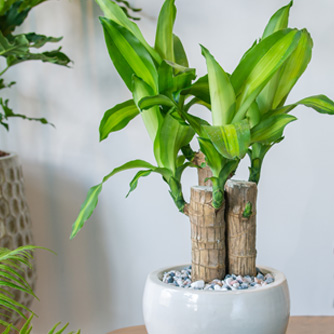
Surely every home needs a beautiful happy plant like this?
Spider plant (Chlorophytum comosum)
Last, but certainly not least on our list, is the incredibly tough spider plant. It's a super attractive plant with ribbon-like foliage that spills out from the central crown. The most commonly grown plant is a variegated form with white and green foliage, but there is also a form with solid green leaves.
Spider plants regularly produce flower spikes which hang lower than the foliage. The white flowers are small and cute, but it's when baby plants form on the ends of the flower spikes that things get interesting. You end up with lots of baby plants hanging from the mother plant like clusters of baby spiders!
This is a great plant for a beginner as it’s adaptable to a range of light conditions, including low light, and is tolerant of neglect. Established plants will handle dry periods so it's great if you are a bit forgetful with watering. Just don't overwater it or you'll cause it to rot.
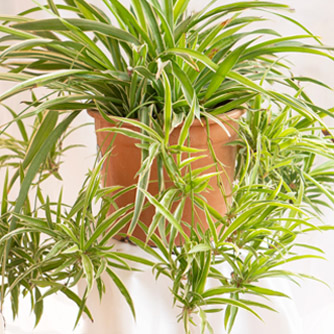
Spider lily with all her hanging babies
Let there be light
And finally, if you don’t want to be limited to these plants, then consider investing in grow lights to brighten a dark space. These lights are specifically made to emit wavelengths that are optimal for plant growth. Regular houselights don't come close to what grow lights can achieve, so they're definitely worth investing in. Look for LED lights which are more energy efficient, and find them at your local hydroponic store, selected garden centres and online.


